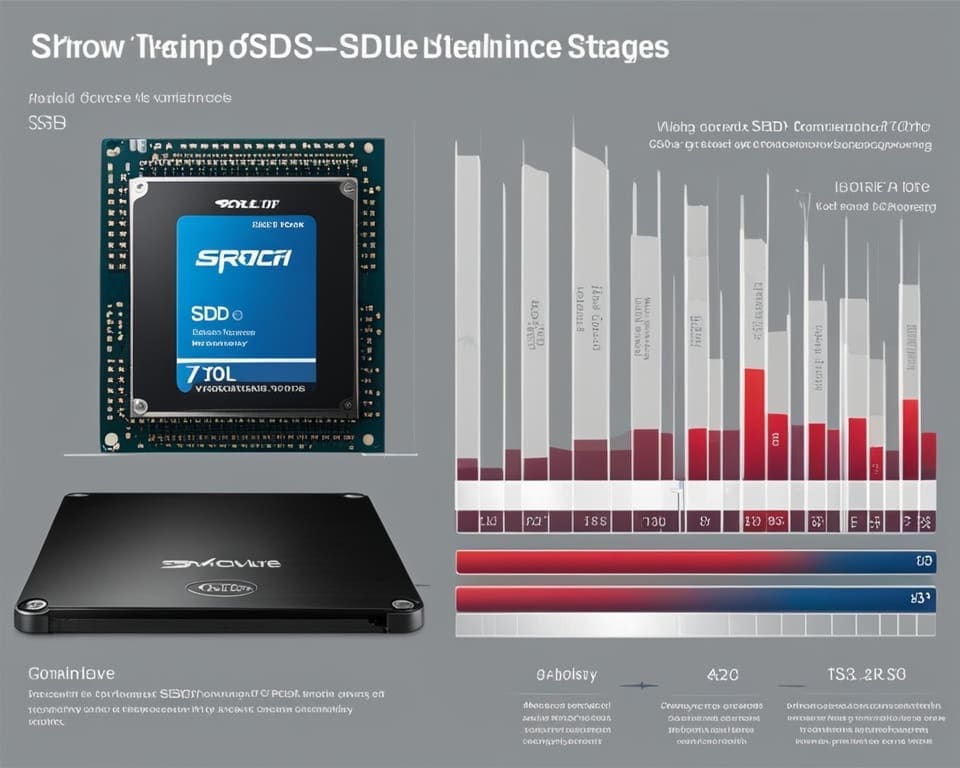Solid State Drives (SSDs) are leading the change in data storage technology. Unlike Hard Disk Drives (HDDs) that have been used for over fifty years, SSDs use flash memory. This gives them benefits like faster speed, more reliability, better durability, and greater energy efficiency.
The need for quick access to data has never been higher. SSD technology is improving fast, offering more storage and lower costs. Even though SSDs were once more expensive, their prices have dropped. This makes them a more appealing option for everyone.
New technology like 3D NAND and NVMe is making SSDs even better. They can handle today’s data needs and are ready for the future too. As people see the benefits of SSDs, their popularity continues to grow. They represent a shift towards more innovative, efficient, and reliable storage solutions.
Understanding SSD Technology and Its Growth
Data storage has changed a lot with SSDs coming into play. Now, SSDs are key in many products like PCs, laptops, and cameras. They use NAND flash memory instead of moving parts. This makes them faster, more durable, and energy-saving.
The Basics of Solid State Drives
SSDs work by storing data in memory cells. There are types like SLC, MLC, and TLC, each with different performances. They offer quicker speeds and low latency. This makes them perfect for apps needing fast operations.
- Quicker boot times for laptops and desktops
- Less power consumption compared to traditional HDDs
- Robust design, leading to longer lifecycles
- Quiet operation, free from mechanical noise
SSDs come in various forms like 2.5-inch drives and NVMe SSDs. This helps them fit into many devices. Their technology improves user experience and productivity.
SSDs and Their Role in Data Centres
In data centres, SSDs play a big role. They handle big workloads well. They’re great for servers and systems needing quick data access. NVMe IOPS rates can get over 1 million. This beats older systems and speeds up response times.
But, SSDs can be more expensive and have limits on write cycles. These are key points for businesses. Still, their impact in data centres is huge. They boost operations and meet the growing need for quick, reliable data storage.

Why SSDs Are the Future of Data Storage
The world of data storage is quickly changing. Solid state drives (SSDs) are at the forefront, pushing us towards a better and more reliable future. When comparing SSDs with HDDs, it’s clear that SSDs win, especially where speed and trust are key.
Performance Advantages Over HDDs
SSDs outshine hard disk drives (HDDs) with impressive speed. They access data up to 100 times faster than HDDs, getting rid of long wait times. This speed is vital for activities that need quick data access, like gaming and video editing. NVMe technology now allows even faster data transfers, enhancing SSD’s performance.
Energy Efficiency and Cost Savings
SSDs also lead the way in energy efficiency. They use less power than HDDs since they have no moving parts. This means they’re cheaper to run and better for the planet. The price of SSDs has dropped, making them more affordable. With growing demands for storage that’s both sustainable and budget-friendly, SSDs are the top option.
Their efficiency and longevity make them a wise choice for future-proofing data storage. SSDs are indeed a smart investment for those looking to save in the long run.
Exploring SSD Market Trends and Innovations
The world of data storage is changing fast, with SSDs leading the charge. A surge in IoT devices and AI tech pushes the demand for SSDs. By 2023, we’ve seen a whopping 14.5 billion IoT devices. This highlights a huge need for effective storage solutions. About 90% of data centres still use old HDDs. This shows there’s a big chance for SSDs to grow as businesses see their speed and reliability benefits.
Rising Demand for SSDs
Companies are quickly adopting AI, with 77% already using or looking into AI tech. This creates a big need for strong, efficient storage. Gartner says that by 2025, nearly all new digital work will be based in the cloud. This makes modern SSDs crucial. They now offer up to 61TB, thanks to 3D NAND tech. This is key for handling the intense data needs of AI and machine learning.
Future Innovations in SSD Technology
Future trends in SSD tech look promising. NVMe tech has already made big workloads much quicker. Plus, QLC tech brings more storage at better prices. This opens new doors for how we store data. Upcoming breakthroughs, like Quantum computing and NRAM, will boost storage and speed. SSDs are set to play a big part in the future of storage.









